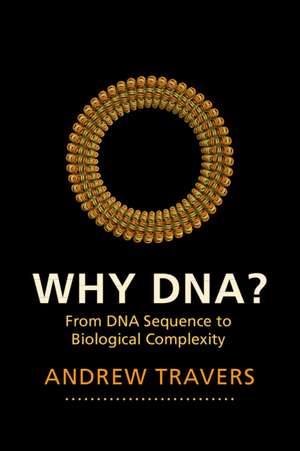Why DNA?: From DNA Sequence to Biological Complexity
Autor Andrew Traversen Limba Engleză Paperback – 16 feb 2022
| Toate formatele și edițiile | Preț | Express |
|---|---|---|
| Paperback (1) | 162.47 lei 3-5 săpt. | +15.53 lei 6-12 zile |
| Cambridge University Press – 16 feb 2022 | 162.47 lei 3-5 săpt. | +15.53 lei 6-12 zile |
| Hardback (1) | 452.84 lei 3-5 săpt. | |
| Cambridge University Press – 16 feb 2022 | 452.84 lei 3-5 săpt. |
Preț: 162.47 lei
Nou
Puncte Express: 244
Preț estimativ în valută:
31.09€ • 32.69$ • 25.69£
31.09€ • 32.69$ • 25.69£
Carte disponibilă
Livrare economică 27 martie-10 aprilie
Livrare express 12-18 martie pentru 25.52 lei
Preluare comenzi: 021 569.72.76
Specificații
ISBN-13: 9781107697522
ISBN-10: 1107697522
Pagini: 222
Dimensiuni: 152 x 228 x 11 mm
Greutate: 0.4 kg
Editura: Cambridge University Press
Colecția Cambridge University Press
Locul publicării:New York, United States
ISBN-10: 1107697522
Pagini: 222
Dimensiuni: 152 x 228 x 11 mm
Greutate: 0.4 kg
Editura: Cambridge University Press
Colecția Cambridge University Press
Locul publicării:New York, United States
Cuprins
Acknowledgements; Preface; 1. The perennial question; 2. The nature of information – information, complexity and entropy; 3. DNA – the molecule; 4. The evolution of biological complexity; 5. Cooperating genomes; 6. DNA, information and complexity; 7. Origins; 8. The complexity of societies; 9. Why DNA – and not RNA?; General reading and bibliography.
Recenzii
'The essence of the book is in its title. The DNA structures and topology are described so clearly that the reader perceives these intricacies as pure evolutionary elegance, and understands WHY it is only in its balance of stability and agility that life could have started its journey. This book explains how DNA has become the fascinating prism, made of a fabric of complexity and information, into which the living reflects itself. My opinion is passionate because I have been thinking about the same problems for decades, and here I find many of the answers. Especially: what makes DNA so unique? It is a text that I keep reading over again.' Ernesto Di Mauro, IBPM, National Research Council, Rome
'In What Is Life? Schrödinger conjectured that, in animate matter, order is derived from order, foreshadowing the discovery of DNA structure. Why DNA? is about this molecule and its dual information content - in linear genetic code and in thermodynamics of three-dimensional DNA structures. It addresses how DNA's intrinsic order led to complex, highly ordered living organisms, in a world that strives towards disorder. Why would DNA supplant RNA in carrying hereditary information during biological evolution? Why did multicellular organisms emerge, since natural selection favours the fittest, such as simple bacteria? What is complexity, and what has it to do with Bayesian logic? How do complexity, information and energy interrelate? This is a succinct discourse on Schrödinger's question, expanding from molecular interactions and genome cooperation to ecological systems and societal evolution. A must-read for biology scholars, and anyone interested in life's origins, biological evolution and the interface of biology and physics.' Georgi Muskhelishvili, Agricultural University of Georgia, Tbilisi
'In What Is Life? Schrödinger conjectured that, in animate matter, order is derived from order, foreshadowing the discovery of DNA structure. Why DNA? is about this molecule and its dual information content - in linear genetic code and in thermodynamics of three-dimensional DNA structures. It addresses how DNA's intrinsic order led to complex, highly ordered living organisms, in a world that strives towards disorder. Why would DNA supplant RNA in carrying hereditary information during biological evolution? Why did multicellular organisms emerge, since natural selection favours the fittest, such as simple bacteria? What is complexity, and what has it to do with Bayesian logic? How do complexity, information and energy interrelate? This is a succinct discourse on Schrödinger's question, expanding from molecular interactions and genome cooperation to ecological systems and societal evolution. A must-read for biology scholars, and anyone interested in life's origins, biological evolution and the interface of biology and physics.' Georgi Muskhelishvili, Agricultural University of Georgia, Tbilisi
Descriere
Describes how the physical chemistry of the DNA molecule links biological complexity, information flux and evolution to energy.
